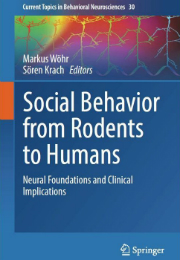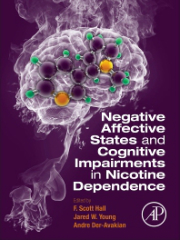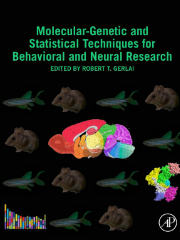MEMBER PUBLICATIONSBEHAVIORAL AND NEURAL GENETICS OF ZEBRAFISH
Key Features
• Provides the most comprehensive snapshot of the fast-evolving zebrafish neurobehavior
genetics field
• Describes behavioral, genetic, and neural methods and concepts employed for adult and
larval zebrafish
• Features examples of zebrafish models of human central nervous system disorders
• Discusses bioinformatics questions pertinent to zebrafish neurobehavioral genetics
ESTROGENS AND MEMORY: BASIC RESEARCH AND CLINICAL IMPLICATIONS Edited by Karyn M. Frick, Ph.D. Estrogens and Memory: Basic Research and Clinical Implications" provides a compendium of cutting-edge basic and clinical research describing the ways in which estrogens regulate memory in a variety of species. Chapters are written by leading experts whose work is on the forefront of this exciting field. The book is organized into three sections focusing on: 1) effects of estrogens on the hippocampus and other brain regions central to memory, 2) effects of estrogens on memory and related cognitive processes throughout the lifespan, and 3) translational implications of estrogenic regulation of memory for aging and disease. This book gives an insider’s perspective on how hormonal regulation of brain function influences cognition and provides a one-stop reference for those interested in learning about the effects of estrogens on memory and the resulting implications for mental health. Edited by Karyn M. Frick, Ph.D. Estrogens and Memory: Basic Research and Clinical Implications" provides a compendium of cutting-edge basic and clinical research describing the ways in which estrogens regulate memory in a variety of species. Chapters are written by leading experts whose work is on the forefront of this exciting field. The book is organized into three sections focusing on: 1) effects of estrogens on the hippocampus and other brain regions central to memory, 2) effects of estrogens on memory and related cognitive processes throughout the lifespan, and 3) translational implications of estrogenic regulation of memory for aging and disease. This book gives an insider’s perspective on how hormonal regulation of brain function influences cognition and provides a one-stop reference for those interested in learning about the effects of estrogens on memory and the resulting implications for mental health.LIFE'S REWARDS: LINKING DOPAMINE, INCENTIVE LEARNING, SCHIZOPHRENIA, AND THE MIND Since their discovery in the 1960s, brain dopaminergic systems have been studied extensively. Life's Rewards: Linking Dopamine, Incentive Learning, Schizophrenia, and the Mind offers a broad synthesis of current understanding of this neurotransmitter, addressing, amongst other things, its intricate relationship with learning and memory, psychopathology, social co-operation, and drug abuse. Since their discovery in the 1960s, brain dopaminergic systems have been studied extensively. Life's Rewards: Linking Dopamine, Incentive Learning, Schizophrenia, and the Mind offers a broad synthesis of current understanding of this neurotransmitter, addressing, amongst other things, its intricate relationship with learning and memory, psychopathology, social co-operation, and drug abuse.Aimed at students and researchers in neuroscience and psychology, Life's Rewards: Linking Dopamine, Incentive Learning, Schizophrenia, and the Mind by Richard J Beninger is essential reading for anyone interested in the relationship between dopamine and reward-related incentive learning. SOCIAL BEHAVIOR FROM RODENTS TO HUMANS - NEURAL FOUNDATIONS AND CLINICAL IMPLICATIONS This compelling volume (editors Markus Wöhr and Sören Krach) provides a broad and accessible overview on the rapidly developing field of social neuroscience. A major goal of the volume is to integrate research findings on the neural basis of social behavior across different levels of analysis from rodent studies on molecular neurobiology to behavioral neuroscience to fMRI imaging data on human social behavior. Contributing authors include Wim Crusio, ChristianKeysers, Jaak Panksepp, Sergio Pellis, and Carmen Sandi. This compelling volume (editors Markus Wöhr and Sören Krach) provides a broad and accessible overview on the rapidly developing field of social neuroscience. A major goal of the volume is to integrate research findings on the neural basis of social behavior across different levels of analysis from rodent studies on molecular neurobiology to behavioral neuroscience to fMRI imaging data on human social behavior. Contributing authors include Wim Crusio, ChristianKeysers, Jaak Panksepp, Sergio Pellis, and Carmen Sandi.NEGATIVE AFFECTIVE STATES AND COGNITIVE IMPAIRMENTS IN NICOTINE DEPENDENCE Negative Affective States and Cognitive Impairments in Nicotine Dependence is the only book of its kind that addresses nicotine use and abuse in the context of negative reinforcement mechanisms. Written and edited by leading investigators in addiction, affective, genetic, and cognitive research (including Scott Hall, Jared Young, and Andre Der-Avakian), it provides researchers and advanced students with an overview of the clinical bases of these effects, allowing them to fully understand the various underlying dysfunctions that drive nicotine use in different individuals. In addition, this book examines animal models that researchers have utilized to investigate the biological bases of these dysfunctions. Negative Affective States and Cognitive Impairments in Nicotine Dependence is the only book of its kind that addresses nicotine use and abuse in the context of negative reinforcement mechanisms. Written and edited by leading investigators in addiction, affective, genetic, and cognitive research (including Scott Hall, Jared Young, and Andre Der-Avakian), it provides researchers and advanced students with an overview of the clinical bases of these effects, allowing them to fully understand the various underlying dysfunctions that drive nicotine use in different individuals. In addition, this book examines animal models that researchers have utilized to investigate the biological bases of these dysfunctions.The combination of clinical and preclinical approaches to understanding nicotine dependence makes this book an invaluable resource for researchers and practitioners seeking to develop targeted treatments aimed at ameliorating symptoms of nicotine dependence, as well as identifying premorbid differences in affective or cognitive function. Key Features • Provides a unique perspective on nicotine dependence that emphasizes negative reinforcement rather than positive reinforcement
• Examines psychiatric comorbidities and alleviation of withdrawal states as motivation for continued tobacco use
• Includes both clinical and preclinical perspectives
• Includes genetic and multi-neurotransmitter perspectives on nicotine use and withdrawal
• Emphasizes heterogeneity of underlying reasons for smoking, the need for multiple animal models to understand this heterogeneity, and the expectation of heterogeneous responses to potential treatments, underscoring the need for personalized therapeutics
Note: This book was actually based upon a symposium presented at the 2014 Annual Meeting of IBNS, after which the editors were approached by Elsevier about doing a book on the subject.
HANDBOOK OF ULTRASONIC VOCALIZATION: A WINDOW INTO THE EMOTIONAL BRAIN Handbook of Ultrasonic Vocalization is an exhaustive resource on ultrasonic vocalization. In this book, Stefan Brudzynski covers important aspects of emission and biological role of these calls from small rodents to large whales. A large part of the book is focused on expression of emotional states, models of affective disorders, addiction, and studies of other neuropathologies. Handbook of Ultrasonic Vocalization is an exhaustive resource on ultrasonic vocalization. In this book, Stefan Brudzynski covers important aspects of emission and biological role of these calls from small rodents to large whales. A large part of the book is focused on expression of emotional states, models of affective disorders, addiction, and studies of other neuropathologies.In addition, the book covers studies of neuroactive agents and sociopsychological conditions that can regulate the outcome of ultrasonic vocalization and provide clues about animals’ internal states. Critically, the book also includes thorough coverage of pharmacological investigations using ultrasonic vocalizations, increasingly being utilized for studies in affective disorders, psychoses, addiction and alcoholism. No other book provides such extensive coverage of this rapidly growing field of study. MOLECULAR-GENETIC AND STATISTICAL TECHNIQUES FOR BEHAVIORAL AND NEURAL RESEARCH The use of recombinant DNA technologies has greatly shaped neuroscience research over the past few decades, as well as the fields of biotechnology and medicine. Molecular-Genetic and Statistical Techniques for Behavioral and Neural Research provides an informative account of some of the most exciting molecular and recombinant DNA techniques of the 21st century as they are employed for the analysis of brain function and behavior. The use of recombinant DNA technologies has greatly shaped neuroscience research over the past few decades, as well as the fields of biotechnology and medicine. Molecular-Genetic and Statistical Techniques for Behavioral and Neural Research provides an informative account of some of the most exciting molecular and recombinant DNA techniques of the 21st century as they are employed for the analysis of brain function and behavior.In this book, Robert Gerlai begins with an introduction to genomic research, presents numerous molecular and genetic methods and concepts utilized in biomedical research, behavioral and neuroscience studies, and, finally, disease diagnosis and research at a molecular level. With its clear presentation of exciting basic research and translationally relevant techniques, it provides critical information for clinicians, researchers, graduate students, and advanced undergraduates, as well as professors teaching in relevant disciplines. Key Features • Introduces the relevant aspects of genomic research and neuroinformatics to neuroscience researchers • Describes the principal methods used to study brain and behavior • Considers bioinformatics, genomic research, and molecular biology strategies for phenotypic analysis • Includes discussion on both forward and reverse genetic approaches and genetic animal models of human diseases, and a section on ethical concerns arising from these methods and their applications
|

 Edited by Robert T. Gerlai, Ph.D. The past decade has seen a rapid accumulation of knowledge on the behavioral characteristics of zebrafish, and numerous novel behavioral paradigms have also been designed for this species. Investigation into the neurobiological basis of behavior using the zebrafish and the number of molecular biology tools developed for this species have also exponentially increased. This simple vertebrate represents an ideal compromise between system complexity and practical simplicity. The nucleotide sequence of its genes is highly similar to that of mammalian homologues. Its body is transparent throughout its embryonic development. It possesses a complex larval and adult behavioral repertoire. It has high fecundity and conveniently small size. And a number of recombinant DNA methods and powerful neurobiological techniques have already been developed for it. Behavioral and Neural Genetics of Zebrafish presents the state-of-the-art methodologies and most current concepts pertinent to the neurobehavioral genetics of the zebrafish. Discussing its natural behavior, perception, motor function, anxiety, aggression, and learning and memory, among other behaviors of both the fry and adult zebrafish, it features a comprehensive account of modern genetic and neurobiological approaches adapted to or specifically developed for Danio rerio. Numerous examples of how behavioral genetic and neuropharmacology methods may be utilized for disease models are also presented, as well as a section on bioinformatics and “big-data” related questions. Focusing on this excellent translational tool, this book examines a species with which investigators may model and analyze even such complex human diseases as addiction, Parkinson’s Disease, Autism, and others associated with brain dysfunction.
Edited by Robert T. Gerlai, Ph.D. The past decade has seen a rapid accumulation of knowledge on the behavioral characteristics of zebrafish, and numerous novel behavioral paradigms have also been designed for this species. Investigation into the neurobiological basis of behavior using the zebrafish and the number of molecular biology tools developed for this species have also exponentially increased. This simple vertebrate represents an ideal compromise between system complexity and practical simplicity. The nucleotide sequence of its genes is highly similar to that of mammalian homologues. Its body is transparent throughout its embryonic development. It possesses a complex larval and adult behavioral repertoire. It has high fecundity and conveniently small size. And a number of recombinant DNA methods and powerful neurobiological techniques have already been developed for it. Behavioral and Neural Genetics of Zebrafish presents the state-of-the-art methodologies and most current concepts pertinent to the neurobehavioral genetics of the zebrafish. Discussing its natural behavior, perception, motor function, anxiety, aggression, and learning and memory, among other behaviors of both the fry and adult zebrafish, it features a comprehensive account of modern genetic and neurobiological approaches adapted to or specifically developed for Danio rerio. Numerous examples of how behavioral genetic and neuropharmacology methods may be utilized for disease models are also presented, as well as a section on bioinformatics and “big-data” related questions. Focusing on this excellent translational tool, this book examines a species with which investigators may model and analyze even such complex human diseases as addiction, Parkinson’s Disease, Autism, and others associated with brain dysfunction. A neuroscientist reveals unique aspects of decision making and the best strategies for protecting and enhancing the brain’s ability to navigate life’s uncertainties.
A neuroscientist reveals unique aspects of decision making and the best strategies for protecting and enhancing the brain’s ability to navigate life’s uncertainties.